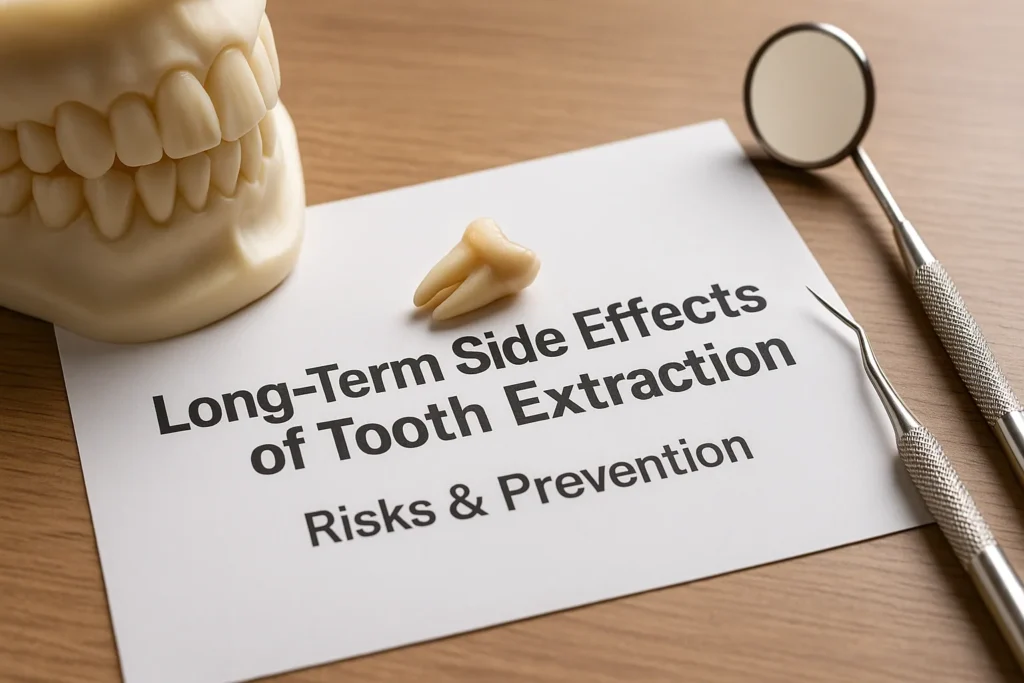I know getting a tooth pulled can feel a little scary. Most of the time, the recovery goes smoothly and people heal without any serious problems. But here’s the thing — sometimes a tooth extraction can leave behind effects that last longer than expected. These are what we call the long-term side effects of tooth extraction.
Now, don’t panic. Not everyone experiences these issues, and many of them can be prevented with good aftercare and proper dental planning. Still, it’s worth knowing what might happen down the road so you can keep an eye out and protect your oral health. Think of this as a friendly guide — the kind of advice you’d get if you were sitting in a dental chair and asking me, “Doc, what should I expect after my tooth is gone?”
In short Definition:
Long-term side effects of tooth extraction include bone shrinkage, shifting teeth, bite changes, and sinus issues. While most people heal well, missing teeth can cause lasting oral health challenges if not managed properly.
By the end of this article, you’ll understand the possible long-term complications, why they happen, and what you can do to avoid them. We’ll also go over some lesser-known risks, real-world examples, and expert-backed tips to help you stay healthy and confident after your extraction.
What Happens After a Tooth Extraction
To understand long-term effects, it helps to know what normally happens right after a tooth is removed. When your dentist or oral surgeon pulls a tooth, your body immediately begins to heal.
- A blood clot forms in the empty socket — this is like a natural bandage that protects the bone and nerves underneath.
- Over the first week or two, gum tissue slowly covers the area.
- Over the next few months, the bone begins to reshape itself.
That’s the natural healing process. Most people experience some short-term side effects like pain, mild bleeding, swelling, or even a bruise on the cheek. These usually fade within a week or two. Some may develop a dry socket — when the blood clot breaks down too soon — which can be painful but is treatable.
Here’s the important part: once the short-term stage is over, your mouth still goes through changes you may not feel right away. That’s where long-term side effects come in.
Why Long-Term Side Effects Develop
So, why do some people face complications months or even years after their extraction? The main reason is that your mouth isn’t designed to work with missing teeth. Every tooth plays a role in how you bite, chew, and even how your jawbone stays strong.
When a tooth is pulled and not replaced, the bone in that area no longer gets the stimulation it used to from chewing. Over time, the bone starts to shrink. This is called bone resorption, and it’s one of the most common long-term effects. Along with that, the teeth around the empty space may shift or tilt into the gap, throwing off your bite.
Other risk factors make long-term side effects more likely:
- Age — Older patients heal slower, and bone resorption is often faster.
- Smoking — Slows healing and raises the risk of infection.
- Chronic health issues — Conditions like diabetes can delay recovery.
- Difficult extractions — Impacted teeth or surgical removals carry higher risk.
Here’s what I tell my patients: having a tooth pulled is one step in the journey. The next step is planning for what comes after. Replacement options like implants, bridges, or even socket preservation procedures can make all the difference in preventing long-term problems.
Common Long-Term Side Effects of Tooth Extraction
Jawbone Shrinkage and Bone Loss
One of the biggest changes that happens after losing a tooth is bone shrinkage. When the tooth and its root are removed, the jawbone in that area no longer has a job to do. Without the pressure from chewing, the bone starts to break down slowly.
This bone loss doesn’t happen overnight. It usually takes months or years, but the result can be noticeable — your jawline may change shape, your cheeks can look more sunken, and if several teeth are missing, it can even alter your facial appearance. That’s why dentists often recommend socket preservation or dental implants, which keep the bone stimulated and strong.
Shifting Teeth and Bite Problems
Here’s the thing — teeth don’t like empty spaces. When one tooth is gone, the neighboring teeth often drift into that gap. This can lead to bite misalignment, chewing difficulties, or even jaw joint pain. Some people notice that their front teeth start to look crooked again, almost like their orthodontic treatment is reversing.
This problem is especially common when extractions are done for braces without a solid plan to keep the bite stable. Over time, shifting teeth can create uneven wear and even more dental issues.
Changes in Facial Appearance
When bone loss and shifting teeth combine, your face shape can change. People sometimes describe it as their bite “collapsing.” The lower part of the face may look shorter, or lips may appear thinner. While these changes take time, they’re a real concern, especially if multiple teeth are missing and not replaced.
Nerve Injury and Lingering Numbness
Some extractions — particularly wisdom teeth or deeply rooted molars — run close to important nerves. In rare cases, those nerves may be bruised or damaged during surgery. The result can be tingling, numbness, or altered sensation in your lips, tongue, or chin.
Most nerve injuries heal within weeks or months, but sometimes the effects linger. That’s why oral surgeons are very careful with X-rays and planning before removing certain teeth.
Sinus Complications (Especially Upper Molars)
If you’ve ever had an upper molar pulled, you may have heard your dentist mention the sinus. These teeth sit very close to your sinus cavity, and in some cases, extraction can leave a small opening between the mouth and sinus. This can lead to sinus infections, pressure, or chronic discomfort.
While this doesn’t happen to everyone, it’s one reason why upper molar extractions are considered more complex. Dentists often recommend special closure techniques to protect the sinus and avoid long-term problems.
Delayed or Incomplete Healing
For most people, the gum tissue heals within weeks. But sometimes small bone fragments or root tips are left behind, leading to irritation, delayed healing, or even chronic infection. This isn’t common, but when it happens, you might notice persistent pain or swelling in the area long after you expected to be healed.
Adjacent Tooth Issues
When a tooth is pulled, the teeth nearby can take extra pressure. This can make them more prone to gum recession, cavities, or sensitivity. In some cases, the extraction site becomes a “trap” for food particles, increasing the risk of gum disease. Keeping up with good oral hygiene and regular dental cleanings can go a long way toward preventing this.
Rare but Serious Long-Term Risks
Jawbone Infection (Osteomyelitis)
Although rare, a bacterial infection can spread into the jawbone. This condition, called osteomyelitis, is painful and requires medical treatment. Symptoms might include fever, swelling, and severe pain. Thankfully, with modern antibiotics and surgical techniques, it’s uncommon.
Osteoradionecrosis
This complication mostly affects people who’ve had radiation treatment for cancer. If the bone’s blood supply is already weakened, pulling a tooth can sometimes trigger long-term bone death in that area. Oral surgeons usually take extra precautions with these patients, such as hyperbaric oxygen therapy, to prevent this.
Jaw Fractures
In very difficult extractions, especially in older patients with brittle bones, there’s a small risk of jaw fracture. It’s rare but serious, and another reason why careful planning matters before pulling certain teeth.
Trismus and Restricted Jaw Movement
Some patients develop stiffness in the jaw joint (trismus) after an extraction, making it harder to open their mouth fully. While this usually improves with time and exercises, in some cases it can become a long-term problem.
Chronic Pain Syndromes
In rare situations, the nerves in the jaw don’t heal properly, and patients develop chronic pain long after the tooth is gone. This is sometimes linked to nerve injury or dry socket that didn’t resolve fully. Dentists often work with pain specialists in these cases to help patients manage symptoms.
Uncommon or Overlooked Long-Term Side Effects
TMJ Problems and Jaw Joint Stress
When your bite changes after an extraction, it can put extra pressure on the temporomandibular joint (TMJ) — the hinge that helps you open and close your mouth. Over time, this extra stress can cause jaw clicking, soreness, or even headaches. You might not connect these issues back to an old extraction, but the two can be linked.
If you ever notice your jaw feels stiff or you wake up with pain in front of your ears, it’s worth checking with your dentist. A custom bite guard or orthodontic adjustment can sometimes help balance things out.
Psychological Impact and Self-Image
Here’s something people don’t always talk about: losing a tooth can affect your confidence. Even if the missing tooth isn’t visible when you smile, you may feel self-conscious knowing it’s gone. Some people avoid certain foods or social situations because of discomfort or embarrassment.
I’ve had patients tell me they stopped smiling in photos after an extraction — not because of pain, but because they felt their smile had changed. That’s why replacing missing teeth is about more than just function. It’s also about feeling good when you look in the mirror.
Systemic Health Links
Believe it or not, tooth loss doesn’t just stay in your mouth. Studies show that missing teeth and long-term oral infections can increase risks for heart disease, diabetes complications, and even memory problems in older adults. That doesn’t mean one extraction automatically causes these conditions, but poor oral health over time can take a toll on overall health.
So, think of your mouth as part of your whole body. Taking care of your teeth and gums is really about taking care of you.
Specific Scenarios and Common Questions
Tooth Extraction Death Rate
Let’s address one of the most worrying questions right away. The risk of dying from a tooth extraction is incredibly rare. Modern dentistry uses safe anesthesia, sterile techniques, and careful monitoring to make extractions one of the most routine surgical procedures. For healthy patients, the death rate is nearly zero. Complications usually arise only in people with severe medical conditions or untreated infections.
Disadvantages of Tooth Extraction
Of course, extractions solve one problem (removing a bad tooth) but can create others if not managed properly. The main disadvantages include:
- Permanent loss of the tooth and its function
- Possible bone shrinkage and shifting teeth
- Added costs for tooth replacement later
This is why dentists often suggest saving a natural tooth when possible through root canal therapy or crowns. Extraction is usually the last resort.
Tooth Extraction Side Effects on Eyes
You may have seen people online asking if pulling a tooth can affect their eyes. The short answer: not directly. Tooth extraction doesn’t damage your eyesight. However, upper molars sit close to your sinuses, which connect to areas near your eyes. Sometimes sinus complications after extraction can cause pressure, swelling, or even a dull ache that feels like it’s coming from the eye. But actual eye damage? That’s a myth.
Long-Term Side Effects of Tooth Extraction for Braces
Orthodontists sometimes remove teeth to make space for braces. Done properly, this works just fine. But if follow-up isn’t managed carefully, gaps can reopen or teeth may shift in ways that weren’t planned. The key is regular orthodontic monitoring and wearing retainers as directed.
Long-Term Side Effects of Tooth Extraction Reddit
If you search Reddit, you’ll find lots of personal stories — some people report bone loss, shifting teeth, or sensitivity years later. While these accounts are helpful to read, remember they’re personal experiences. Everyone heals differently. Always double-check with a dental professional rather than relying only on forums.
Tooth Extraction Healing Stages Pictures
Many patients ask what “normal” healing looks like. Pictures can help, but here’s a quick guide instead:
- First night after tooth extraction: expect bleeding to slow, clot formation, mild swelling.
- First week: swelling and discomfort should improve, gum tissue starts closing.
- One month: the gum looks more normal, but bone underneath is still healing.
- Six months+: bone reshaping continues, and without replacement, shrinkage may show.
Looking at your healing site daily can help, but if something looks unusual (large holes, persistent bleeding, bad odor), check with your dentist.
Upper Molar Extraction Complications
Upper molars are special cases because of their closeness to the sinus cavity. Long-term effects may include sinus infections, bone loss, or even small openings between the sinus and mouth. That’s why dentists handle these extractions with extra care and sometimes recommend bone grafting afterward.
First Night After Tooth Extraction
The first night sets the tone for healing. Here’s what you should do:
- Bite gently on the gauze to control bleeding.
- Avoid using straws, spitting forcefully, or smoking — all of which can dislodge the clot.
- Stick to soft foods and drink plenty of water.
- Sleep with your head slightly elevated to reduce swelling.
If you take care of the site during the first night and first week, you dramatically lower your risk of long-term side effects.
How to Minimise the Risk of Long-Term Side Effects
The good news is most long-term issues can be prevented. It starts before the extraction even happens. If your dentist knows you’ll need a tooth pulled, they may suggest socket preservation — a small bone graft placed in the socket to keep the jaw strong. This can make future implants easier and reduce bone shrinkage.
Another big step is choosing how to replace the missing tooth. Options include:
- Dental implants — the closest thing to a natural tooth, keeps bone stimulated.
- Bridges — fills the gap using neighboring teeth as support.
- Dentures — removable, more affordable, but don’t stop bone loss.
Aftercare is just as important. Follow these tips:
- Stick to soft foods for the first few days.
- Avoid straws, spitting, or smoking — they can break the clot.
- Keep the area clean with gentle rinsing (as your dentist recommends).
- Get enough rest — your body heals best when you’re not stressed.
And don’t forget the follow-up visit. A lot of people skip it once they feel better, but your dentist can spot early signs of trouble long before you do.
When to Seek Professional Help
Sometimes, things don’t go as planned. Here are warning signs you should never ignore:
- Pain or swelling that gets worse after the first week
- Numbness or tingling that doesn’t fade within a few days
- Signs of infection like fever, pus, or bad taste
- Difficulty opening your mouth (trismus) that lasts weeks
- Shifting bite or teeth that suddenly feel uneven
If you notice any of these, call your dentist or oral surgeon right away. The sooner issues are treated, the less chance they’ll turn into long-term complications.
Cost and Lifestyle Implications
Skipping tooth replacement might feel like a money saver in the short run. But here’s the reality — the long-term costs often add up. Bone loss can make future implants more complicated and expensive. Shifting teeth can mean braces again, even for adults.
Lifestyle also takes a hit. Missing teeth can change how you chew, limit what you eat, or affect your speech. Some patients tell me they avoid steak or crunchy foods for years after an extraction because chewing just doesn’t feel right.
The best approach is to think long-term. Replacing the tooth early often costs less than fixing years of problems later.
Advances in Dentistry That Reduce Risks
Dentistry today is far ahead of where it was even 20 years ago. A few modern tools make extractions safer and reduce long-term effects:
- Socket preservation grafts — keep bone volume in place after extraction.
- Guided implant surgery — places implants with high precision, restoring function quickly.
- Laser-assisted surgery — reduces trauma, speeds up healing.
- 3D imaging (CBCT scans) — lets dentists see nerves and sinuses clearly before surgery.
The best part is many of these techniques are now common in everyday dental practices, not just specialist clinics.
Comparison Table: Short-Term vs Long-Term Side Effects
| Short-Term Side Effects | Long-Term Side Effects |
| Pain, swelling, mild bleeding | Bone loss in the jaw |
| Dry socket (blood clot dislodges) | Teeth shifting and bite misalignment |
| Bruising on cheeks or jaw | Changes in facial appearance |
| Temporary difficulty chewing | Sinus complications (upper molars) |
| Infection at the site (rare) | Nerve injury or chronic jaw pain |
Bullet List: How to Reduce Long-Term Side Effects
- Replace missing teeth with implants, bridges, or dentures
- Ask your dentist about socket preservation bone grafts
- Follow aftercare instructions closely (first week matters most)
- Avoid smoking, alcohol, and straws during healing
- Schedule regular follow-ups to catch early signs of trouble
Conclusion
So, let’s bring it all together. The long-term side effects of tooth extraction are real, but they’re not something to live in fear of. Bone loss, shifting teeth, sinus problems, and even rare risks like jaw fractures are possible — but with planning, care, and good follow-up, most patients avoid serious problems.
Think of it this way: getting a tooth pulled is just the first step. What you do afterward matters even more. Replacing the tooth, caring for your gums, and checking in with your dentist are the keys to staying healthy for years to come.
If you’ve recently had a tooth removed, keep an eye on your healing and don’t hesitate to ask questions. A short visit now could save you from big problems later. And if you’re planning an extraction, talk with your dentist about socket preservation, implants, or other ways to protect your smile long-term.
Here’s the thing — you don’t have to let a missing tooth change your life. With today’s dentistry, you’ve got plenty of options to keep your smile strong, your bite healthy, and your confidence intact.
FAQ
Can tooth extraction cause headaches?
Yes, sometimes bite changes or jaw joint stress can lead to headaches, but it’s usually temporary.
How long does numbness last after extraction?
Most numbness fades within a few hours or days. If it lingers for weeks, see your dentist.
Do teeth always shift after one is removed?
Not always, but it’s very common if the space isn’t filled.
Can jawbone grow back after extraction?
Unfortunately, no. Once bone shrinks, it doesn’t naturally regenerate. That’s why bone grafts and implants are so important.
Is it safe to leave an empty socket long-term?
It’s possible, but not ideal. Over time, bone loss and shifting teeth are likely. Replacing the tooth gives the best outcome.
Why is tooth extraction not recommended?
Dentists prefer to save natural teeth whenever possible. Extraction can cause bone loss, shifting teeth, and bite changes. It’s usually the last option when a tooth can’t be restored.
Is nerve damage after tooth extraction permanent?
In most cases, nerve irritation heals within weeks or months. Permanent damage is rare but possible, especially with wisdom teeth or deeply rooted molars.
Can teeth extraction cause stomach problems?
Indirectly, yes. Missing teeth may limit what you eat, leading to poor digestion or nutritional changes. Tooth loss itself doesn’t damage the stomach, but chewing difficulties can affect diet.
Does tooth extraction have any side effects?
Yes. Short-term side effects include pain, swelling, and bleeding. Long-term effects can include jawbone shrinkage, teeth shifting, sinus issues, or chronic jaw pain if the tooth isn’t replaced.
Disclaimer
This article is for educational purposes only and should not replace professional dental advice. Every patient’s situation is unique. If you’ve had a tooth extraction or are considering one, consult your dentist or oral surgeon for personalized guidance and treatment options.

Hi, I’m Bilal, the founder of outofmagazine.com. I love sharing fresh ideas, stories, and helpful insights on all kinds of topics that spark curiosity. My goal with this site is simple—to create a space where readers can find inspiration, useful tips, and engaging reads on lifestyle, trends, and everything in between.



